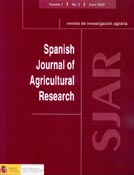Ver ítem
- xmlui.general.dspace_homeCentros Regionales y EEAsCentro Regional Buenos Aires SurEEA BarrowArtículos científicosxmlui.ArtifactBrowser.ItemViewer.trail
- Inicio
- Centros Regionales y EEAs
- Centro Regional Buenos Aires Sur
- EEA Barrow
- Artículos científicos
- Ver ítem
Occurrence and distribution of soil Fusarium species under wheat crop in zero tillage
Resumen
The presence of Fusarium species in cultivated soils is commonly associated with plant debris and plant roots. Fusarium species are also soil saprophytes. The aim of this study was to examine the occurrence and distribution of soil Fusarium spp. at different soil depths in a zero tillage system after the wheat was harvested. Soil samples were
obtained at three depths (0-5 cm, 5-10 cm and 10-20 cm) from five crop rotations: I, conservationist agriculture
[ver mas...]
The presence of Fusarium species in cultivated soils is commonly associated with plant debris and plant roots. Fusarium species are also soil saprophytes. The aim of this study was to examine the occurrence and distribution of soil Fusarium spp. at different soil depths in a zero tillage system after the wheat was harvested. Soil samples were
obtained at three depths (0-5 cm, 5-10 cm and 10-20 cm) from five crop rotations: I, conservationist agriculture (wheatsorghum-soybean); II, mixed agriculture/livestock with pastures, without using winter or summer forages (wheatsorghum-
soybean-canola-pastures); III, winter agriculture in depth limited soils (wheat-canola-barley-late soybean); IV, mixed with annual forage (wheat-oat/Vicia-sunflower); V, intensive agriculture (wheat-barley-canola, with alternation of soybean or late soybean). One hundred twenty two isolates of Fusarium were obtained and identified as F. equiseti, F. merismoides, F. oxysporum, F. scirpi and F. solani. The most prevalent species was F. oxysporum, which was observed in all sequences and depths. The Tukey’s test showed that the relative frequency of F. oxysporum under intensive
agricultural management was higher than in mixed traditional ones. The first 5 cm of soil showed statistically significant differences (p = 0.05) with respect to 5-10 cm and 10-20 cm depths. The ANOVA test for the relative frequency of the
other species as F. equiseti, F. merismoides, F. scirpi and F. solani, did not show statistically significant differences (p ≤ 0.05). We did not find significant differences (p ≤ 0.05) in the effect of crop rotations and depth on Shannon, Simpson indexes and species richness. Therefore we conclude that the different sequences and the sampling depth did
not affect the alpha diversity of Fusarium community in this system.
[Cerrar]

Autor
Silvestro, Luciana Belén;
Steinglein, Sebastian Alberto;
Forjan, Horacio Jose;
Dinolfo, María Inés;
Arambarri, Angélica Margarita;
Manso, Marina Lucrecia;
Moreno, María Virginia;
Fuente
Spanish journal of agricultural research 11 (1) : 72-79. (2013)
Fecha
2013
ISSN
1695-971-X
2171-9292 (Online version)
2171-9292 (Online version)
Formato
pdf
Tipo de documento
artículo
Palabras Claves
Derechos de acceso
Abierto
 Excepto donde se diga explicitamente, este item se publica bajo la siguiente descripción: Creative Commons Attribution-NonCommercial-ShareAlike 2.5 Unported (CC BY-NC-SA 2.5)
Excepto donde se diga explicitamente, este item se publica bajo la siguiente descripción: Creative Commons Attribution-NonCommercial-ShareAlike 2.5 Unported (CC BY-NC-SA 2.5)


